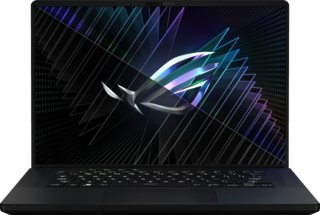Asus ROG Zephyrus M16 (2023) 16" QHD Plus Intel Core i9-13900H vs Dell Alienware M16 16" QHD Plus Intel Core i7-13700HX
Searching for a robust gaming laptop? Consider the Asus ROG Zephyrus M16 (2023) and the Dell Alienware M16. Both models are high-performance machines wrapped in sleek designs, each with standout features to cater to different gaming needs.
The Asus Zephyrus, powered by a 2.6GHz Intel Core i9-13900H processor and an Nvidia GeForce RTX 4080 graphics card, is designed for demanding games that require top-tier graphics. The Dell Alienware, while slightly less powerful with a 2.1GHz Intel Core i7-13700HX processor and an Nvidia GeForce RTX 4060 graphics card, still packs enough punch to meet all your gaming requirements.
Both machines share a generous helping of 64GB RAM to ensure smooth multitasking during your gaming sessions. However, they significantly differ in storage capacity. The Asus comes with a sizable 2TB SSD, but the Dell takes it up several notches with a massive 8TB SSD - an ideal choice for those with extensive game collections.
So, whether you prioritize superior graphics or ample storage space, either of these laptops could be your new gaming companion!
System and application performance
Performance in popular 3D games
Viewing angle, color accuracy...
Ports, webcam and other interfaces
Potential battery life
Materials, durability and portability
Performance Comparison
| Asus ROG Zephyrus M16 (2023) 16" QHD Plus Intel Core i9-13900H | Dell Alienware M16 16" QHD Plus Intel Core i7-13700HX | |
|---|---|---|
| Passmark | 29695 | 31983 |
| Passmark Single | 3910 | 4006 |
Comparing the performance of the Asus ROG Zephyrus M16 (2023) and the Dell Alienware M16 involves considering factors like Passmark scores and specific hardware specifications. Understanding how these elements influence real-world tasks and applications for various user groups is key.
Passmark Scores:
- Asus ROG Zephyrus M16:
- Passmark: 29695
- Passmark Single: 3910
- Dell Alienware M16:
- Passmark: 31983
- Passmark Single: 4006
Performance Analysis:
- Processing Power:
- The Dell Alienware M16 surpasses the Asus ROG Zephyrus M16 in Passmark scores, showcasing superior processing capabilities.
- The higher single-core Passmark score of the Dell model indicates its potential strength in single-threaded tasks that depend on individual core performance.
- Graphics Performance:
- The Asus ROG Zephyrus M16 features an Nvidia GeForce RTX 4080, providing better graphics processing performance than the Nvidia GeForce RTX 4060 in the Dell Alienware M16.
- The Asus model offers enhanced GPU capabilities that can improve frame rates and rendering speeds for gamers and designers.
- Memory and Storage:
- Both laptops offer generous memory (64GB RAM) for multitasking and demanding applications.
- The Dell Alienware M16's extensive storage capacity (4TB SSD + 4TB SSD) can benefit users with significant file handling or vast data storage requirements.
User Scenarios:
- Gamers:
- Gamers looking for exceptional graphics performance may consider the Asus ROG Zephyrus M16 with its Nvidia GeForce RTX 4080 GPU.
- If you value overall system performance, you might consider the Dell Alienware M16 for its superior Passmark score.
- Design Professionals:
- Designers focusing on rendering speeds could benefit from the Asus model's superior GPU.
- Professionals requiring extensive storage might find the Dell Alienware M16 more suitable with its larger storage capacity.
- General Productivity:
- Users engaging in general productivity tasks may not notice significant differences between the two laptops in day-to-day usage.
- However, those working on resource-intensive applications could experience smoother performance on either laptop based on specific task requirements.
In summary, the Dell Alienware M16 offers superior processing power based on Passmark scores, whereas the Asus ROG Zephyrus M16 excels in graphical performance with its Nvidia GeForce RTX 4080 GPU.
Design Comparison
Size Comparison
Let's explore how the design of the Asus ROG Zephyrus M16 (2023) and the Dell Alienware M16 impacts user experience, portability, and overall aesthetic appeal, catering to diverse user preferences.
1. Weight and Dimensions:- The Asus ROG Zephyrus M16 weighs 5.1 pounds and is slimmer at 0.8 inches thick, making it more portable compared to the Dell Alienware M16, which weighs 7.2 pounds and has a thickness of 1 inch.- The Asus model provides enhanced portability and ease of transportation for students needing to bring laptops to classes or professionals who are often on the go.
2. Keyboard and Input Features:- Both laptops come with backlit keyboards to enhance visibility in low-light environments.The Asus ROG Zephyrus M16 provides various connectivity options such as USB 4 40gbps and Thunderbolt 4 ports, while the Dell Alienware M16 offers USB 3.2 Gen 1 ports for older devices.
- Professionals requiring multiple high-speed connections may find the Asus model more suitable due to its advanced port options.
3. Connectivity and Multimedia Features:- Both laptops come equipped with HDMI outputs, USB Type-C ports, Wi-Fi connectivity, front-facing cameras, stereo speakers, and audio jacks.- The Dell Alienware M16 is distinguished by its RJ45 ports, providing reliable wired network connectivity for users requiring stable internet access in professional environments.
4. Build Quality and Materials:- The laptops provide durable build quality common in gaming laptops, with materials varying depending on the model.- Users who prioritize premium aesthetics may prefer the sleek design of the Asus ROG Zephyrus M16, which boasts a thinner form factor when compared to the bulkier look of the Dell Alienware M16.
In conclusion:
For users who value portability and modern design aesthetics, the Asus ROG Zephyrus M16 stands out for its lightweight construction and slim design. Meanwhile, professionals in need of extensive connectivity options and wired networking capabilities might prefer the Dell Alienware M16 for its strong features.
Screen Comparison
| Asus ROG Zephyrus M16 (2023) 16" QHD Plus Intel Core i9-13900H | Dell Alienware M16 16" QHD Plus Intel Core i7-13700HX | |
|---|---|---|
| Refresh Rate | 240 hz | 165 hz |
| Resolution | QHD | QHD |
| Screen Size | 16" | 16" |
Let's dive into the screen specs of the Asus ROG Zephyrus M16 (2023) and Dell Alienware M16 to compare their user experience impact.
Screen Size:
- Both laptops have a 16-inch screen size, striking a balance between portability and an immersive viewing experience.
Resolution:
- The Asus ROG Zephyrus M16 and Dell Alienware M16 feature a QHD Plus resolution of 2560 x 1440 pixels, providing sharp image quality suitable for graphic design tasks and immersive gaming.
Pixel Density:
- Both models offer a pixel density of 188 pixels per inch (ppi), delivering sharp visuals with vivid colors and intricate details.
Display Technology:
- The Asus ROG Zephyrus M16 features Mini-LED technology, which offers superior brightness, contrast ratios, and color accuracy. It is ideal for individuals who value high-quality visuals, such as content creators and gamers.
- In contrast, the Dell Alienware M16 comes with LED-backlit display technology, ensuring dependable performance with accurate color reproduction and energy efficiency. Though not as cutting-edge as Mini-LED, it provides excellent visuals for a wide range of activities.
Refresh Rate:
- The Asus ROG Zephyrus M16 features a high refresh rate of 240Hz, outperforming the Dell Alienware M16's 165Hz rate. This increased refresh rate ensures smoother motion during high-speed gameplay, granting gamers seeking seamless performance an advantage.
Anti Reflection Coating:
- The Asus ROG Zephyrus M16 is outfitted with anti-glare coating, minimizing screen reflections to improve visibility in different lighting settings, ideal for outdoor or well-lit use.
Supported Displays:
- Both laptops can connect to four external displays, allowing users to expand their workspace or create multi-monitor setups for increased productivity or immersive gaming.
To wrap up, both laptops boast impressive screen specs ideal for gaming and professional endeavors such as graphic design. The Asus ROG Zephyrus M16 stands out with its superior refresh rate and cutting-edge Mini-LED display technology, delivering exceptional visual performance. Conversely, the Dell Alienware M16 features dependable LED-backlit technology that offers good color reproduction.
Hardware Comparison
| Asus ROG Zephyrus M16 (2023) 16" QHD Plus Intel Core i9-13900H | Dell Alienware M16 16" QHD Plus Intel Core i7-13700HX | |
|---|---|---|
| CPU | Intel Core i9-13900H | Intel Core i7-13700HX |
| RAM | 64GB | 64GB |
| Storage Size | 2048GB | 4096GB |
Comparison of Hardware Between Asus ROG Zephyrus M16 (2023) and Dell Alienware M16
When it comes to high-performance gaming laptops, the Asus ROG Zephyrus M16 (2023) and Dell Alienware M16 are notable for their powerful hardware setups. Let's compare their key components thoroughly.
- CPU:
- Asus ROG Zephyrus M16: Features Intel Core i9-13900H processor at 2.6GHz.
- Dell Alienware M16: Powered by Intel Core i7-13700HX processor at 2.1GHz
Performance Impact: The Core i9 in the Asus model outperforms the i7 in the Dell, providing enhanced processing capabilities for tasks such as gaming and content creation.
- GPU:
- Asus ROG Zephyrus M16: Nvidia GeForce RTX 4080
- Dell Alienware M16: Nvidia GeForce RTX 4060
Performance Comparison: The RTX 4080 in the Asus laptop delivers superior performance to the RTX 4060 in the Dell, resulting in smoother gameplay and improved graphics rendering.
- RAM:
- Both laptops feature 64GB RAM with slightly different RAM speeds.
Performance Impact: The ample amount of RAM ensures seamless multitasking and efficient performance when running multiple applications simultaneously.
- Storage:
- Asus ROG Zephyrus M16: 2TB SSD
- Dell Alienware M16: Dual configuration of 4TB SSD + 4TB SSD
Performance Impact: While both laptops offer generous storage capacity, Dell's dual SSD setup may provide faster data access speeds compared to a single SSD configuration in the Asus model.
- Additional Features:
- Both laptops support advanced features like PCIe 4.0 for faster data transfer rates.
- The semiconductor size is smaller in the Dell model, potentially leading to improved power efficiency and thermal performance.
In conclusion, if you prioritize raw processing power and GPU performance for intensive tasks like gaming or multimedia editing, the Asus ROG Zephyrus M16 with its superior CPU and GPU might be the ideal choice. On the other hand, if storage speed and efficiency are critical for your workflow, the Dell Alienware M16's dual SSD configuration could offer an advantage.
Verdict
Why Asus ROG Zephyrus M16 (2023) 16" QHD Plus Intel Core i9-13900H?
- Superior processing power with Intel Core i9-13900H.
- Enhanced graphics performance with Nvidia GeForce RTX 4080.
- Cutting-edge Mini-LED display technology for exceptional visual performance.
Why ?
- Superior Passmark scores indicating better processing power.
- Larger storage capacity with a dual 4TB SSD configuration.
- RJ45 ports for stable wired network connectivity in professional environments.
Similar comparisons
- Asus ROG Zephyrus G14 (2022) GA402RK 14" AMD Ryzen 9 6900HS vs Razer Blade 16 (2023) 16" QHD Plus Intel Core i9-13950HX
- Asus ROG Strix G17 Intel Core i7-10875H vs HP ZBook Studio 15.6" Intel Core i7 6820HQ
- Apple MacBook Pro (2015) 15" vs Dell Alienware X17 R1 Intel Core i7-11800H
- Apple MacBook Pro (2015) 15" vs Dell XPS 13 (2020) 13.4" Intel Core i5-1035G1
- Asus ROG GX700 17.3" Intel Core i7 6820HK vs Xiaomi RedmiBook Pro 14 Intel Core i5-1135G7

